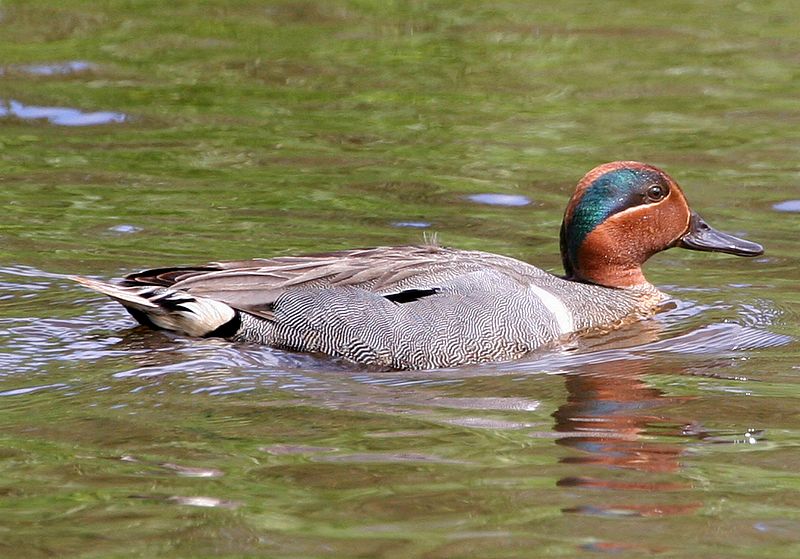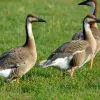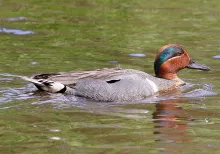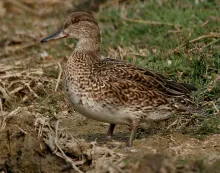
Green-winged Teal (Anas (crecca) carolinensis)
Species name
- Dutch name:
- Wintertaling (amerikaanse)
- English name:
- Green-winged Teal
- German name:
- Nordamerikanische Krickente
- French name:
- Sarcelle à ailes vertes
- Scientific name:
- Anas (crecca) carolinensis
Scientific classification
- Order:
- Anseriformes
- Family:
- Anatidae
- Onderfamilie:
- Anatinae
- Genus:
- Anas
Description
- Description:
Male:
Prominent broad iridescent green stripe, boarded buff, curving from the eye back of shaggy nape, on bright chestnut head. Buffish, dark-spotted breast, finely vermiculated grey flanks and whitish belly; undertail converts pale yellowish buff, boarded black. Upperparts grey brown with paler margins; outer scapulars white, edged black, forming horizontal white stripe above flanks; tail grey brown. Speculam green (towards base of wing) and black, boarded fore and aft with white; rest of upper wing grey brown; underwing whitish with dark flight feathers. Bill black, feet and legs are dark grey.Female:
Mottled brown almost all over, with darker crown and thin dark eye stripe, often with lighter areas between bill and eye. breast and underparts, to tail, buff brown with darker scallops, especially on flanks, but more whitish, streaked darker, in centre of belly and vent. Narrow buff line along edge of tail. Upperparts dark brown, with paler markings. Wing less green on speculum and white borders narrower in front and slightly wider in behind. Overall tone variable, some birds with bolder, cinnamon-tinged feather edgings, while others darker especially on head and upperparts. Bill dark olive with yellow at sides with some black dots and base; legs and feet grey.Juvenile:
Looks similar to female. But males are in full color by the end of their first winter.
- Behaviour:
Green-winged Teal are dabbling ducks that feed on vegetation by tipping up in shallow water or by picking at food items while standing in puddles, flooded fields, and margins of wetlands.
Standard Measurements
- Body Length (cm):
- The male (drake) of the Green-winged Teal measures approximately 35-40 centimeters. The female measures approximately 35-40 centimeters.
- Body Weight (grams):
- The male will weight about 340-360 gram. The female will weight about 340-360 gram.
The weight is notoriously variable and can only be used as indication!
- Note:
Dabbling Ducks are generally hardy, easy to maintain and easy to breed. Shelter may be required by some of the smaller species in winter. They should be provided with cover (including marginal pond cover) and loafing areas as well as water. A pen which is 50% water is suggested. The water may be shallow (i.e. no more than two feet deep is required), and muddy areas for dabbling in are also appreciated. These ducks are generally good in mixed collections, although the smaller and quieter species may be bullied. Territorial disputes between ducks of the same species may be avoided by keeping only one pair of each species in an enclosure, unless the area is very large. For a single pair of ducks a pen are of 50 to 100 square metres, depending on the size of duck, should be provided.
Greenwings form pair ponds relatively late in the season compared with other dabbling ducks, often not until late January all the way to March. Although they break their pair bond each year, Greenwings are monogamous throughout the breeding season; however, occasionally paired males will attempt forced extra-pair copulations with other females.
- Breeding:
- The female Green-winged Teal usually lays from 6-9 creamy white to pale olive-buff eggs and incubates them for 21-23 days.
- Artificial incubating:
The ideal relative humidity for incubating most waterfowl eggs is 55% (ground nesters) and 40% (cavity nesters). The temperature is usually 37.4°C. Set ventilation as recommended by the incubator manufacturer. Eggs must be turned, either automatically or by hand, a minimum of 4 times a day. As the duckling develops there is a loss of water from the egg and the air sac gets bigger. In normal development of an egg with a 21-23 days incubation, the air sac occupies about a third of it three days earlier. Cleanliness is vital and ideally eggs should be moved to a separate hatcher at this point, where the humidity should be increased to 65% and even higher once they have pipped internally.
- Bird banding:
- Recommended closed leg band ring size for the Green-winged Teal is 6.5 mm.The leg band ring can only be applied on a young dabbling duck at around 10-12 days old.
- It doesn't matter what leg that you band, but it's good to have a consistent system. Suggested: Left leg = Female, Right leg = Male
- Maintenance food:
-





Lundi Regular with a protein content of 20%, valuable Spirulina and high-quality by-products is optimally balanced in its composition maintenance food for water ornamental fowl of all kinds. Especially green teal and Whistling ducks that are not dependent on a very high protein content, are well supplied.
Lundi Regular contains all the minerals and vitamins in full form that are important for the animals. Therefore also suitable as breeding food.
- Regulation:
- Europese soort
- Regulation:
Het is niet verboden om deze vogels te houden die van nature in Nederland voorkomen, op voorwaarde dat deze vogels in gevangenschap zijn geboren; nakweek dus. Deze vogels zijn voorzien van een gesloten pootring. Het is wel verboden om deze vogels te houden die in het wild gevangen zijn. Alleen bepaalde instanties, zoals vogelasiels en vogelhospitalen, zijn bevoegd om jonge en gewonde wilde vogels te houden. Deze bescherming van vogels wordt vormgegeven door schadelijke handelingen te verbieden zoals:het doden, verwonden, vangen, bemachtigen en met het oog daarop opsporen van vogels (art. 9 Flora- en faunawet); het opzettelijk verontrusten van vogels (art. 10 Flora- en faunawet);het beschadigen, vernielen, uithalen, wegnemen en verstoren van nesten, holen of andere voortplantings- of vaste rust- of verblijfplaatsen van vogels (art. 11 Flora- en faunawet);en het zoeken, rapen, uit het nest nemen, beschadigen of vernielen van eieren van vogels (art. 12 Flora- en faunawet).



